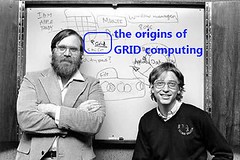
- Image by psd via Flickr
Enabling Grids for E-sciencE (EGEE) is the world’s largest multi-disciplinary computing grid, supporting the research of thousands of scientists and bringing together to the processing power of hundreds of thousands of computers worldwide. The grid and the software that glues it all together, known as middleware, is designed to run on a widely diverse range of computers. Now, a team from Ireland has adapted the grid software gLite to run on the Play Station 3. An Italian group has been able to use the iPhone to access grid enabled digital repositories.
Since 2007 researchers from Trinity College Dublin (TCD) and the Royal College of Surgeons Ireland (RCSI) have been collaborating on the computing challenge inherent in drug discovery, and so when in the latter half of 2008 Symbiosis Ltd introduced a PS3 port of their eHITS drug discovery, the TCD team began in early 2009 to look into adapting, or porting EGEE’s grid middleware, gLite, to the PS3 platform. Since then their PS3 cluster has grown to 16 machines, which they can use to investigate the interactions between possible drug candidates and the diseases they are trying to treat. What makes this possible are the seven Synergistic Processing Elements (SPEs) that give the machine its computational power at relatively low cost. These elements are designed especially to support the complex 3D vector calculations that enable graphic intensive gaming — but also happen to be ideally suited to the team’s drug discovery work.
Eamonn Kenny who is on the TCD team was delighted with how well received the work has been by EGEE, “EGEE represents a major platform for European science, and its impetus toward multi-platform support is extremely helpful.”
While the EGEE computing grid is known for supplying huge amounts of processing power, it also provides a framework that allows databases and other information sources to be interlinked easily. Teams looking to create global digital repositories can use the grid to give access to their resources to research communities from all over the world. With both smart phones and high speed 3G networks moving rapidly into the mainstream a group of researchers from INFN Catania and University of Catania in Sicily saw an opportunity for an application to allow people access to digital repositories wherever and whenever they want.
Related articles by Zemanta
- Grid, Distributed and Cloud Computing Resources (theworldwellinherit.blogspot.com)







![Reblog this post [with Zemanta]](http://img.zemanta.com/reblog_b.png?x-id=012b8280-3459-4fad-af79-7793cfcd185d)
